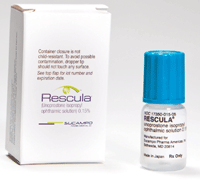 A 55-year-old man was diagnosed with early primary open-angle glaucoma OD and ocular hypertension OS. He had minimal field loss in the right eye, but no visual problems in the left eye.
A 55-year-old man was diagnosed with early primary open-angle glaucoma OD and ocular hypertension OS. He had minimal field loss in the right eye, but no visual problems in the left eye.
His central corneal thickness measured 530µm OU, and his intraocular pressure was 25mm Hg OD and 24mm Hg OS. His general health was remarkable for elevated cholesterol levels, which were controlled with a statin drug, and chronic obstructive pulmonary disease (COPD), which was controlled with an inhaler.
We started him on a prostaglandin analog. While the resultant IOP reduction was significant, so was the associated hyperemia. So, we tried another prostaglandin analog and noted similar intolerability.
Considering his COPD, topical beta-blockers were not a viable option––either alone or in fixed combination agents. Seemingly, that left topical carbonic anhydrase inhibitors and alpha-2 adrenergic agonists as the remaining choices in medical therapy.
At least, those medication classes were our last choices until the re-release of Rescula (unoprostone isopropyl 0.15%, Sucampo Pharmaceuticals)––a topical ophthalmic solution indicated for lowering IOP in patients with glaucoma or ocular hypertension. In this month’s column, we’ll take a fresh look at Rescula.
A Glance at Prostones
Prostones are a class of naturally occurring compounds that result from enzymatic catalysis of eicosanoids and docosanoids by 15-PGDH. Prostones are believed to be activators of cellular ion channels that promote fluid secretion and enhance cell protection, including the recovery of cellular barrier function. This activity gives prostones wide-ranging therapeutic potential.

As an example, lubiprostone is a bicyclic fatty acid derivative that locally activates type 2 chloride channels (ClC-2) without activation of prostaglandin receptors.1,2 It is considered to have fundamentally different cellular effects than prostaglandins. Lubiprostone is clinically available as Amitiza (Sucampo Pharmaceuticals), which is indicated to treat constipation-predominant irritable bowel syndrome.2
Rescula’s Debut
Rescula initially was FDA approved in 2000 to lower IOP in patients with glaucoma and ocular hypertension who were either intolerant of other medications or needed greater pressure reduction than their current drug therapy provided. The labeled dosing frequency was BID.
Unoprostone was developed from a prostaglandin metabolite, but the compound itself was considered to be a docosanoid with properties principally different from prostaglandin analogs. At the time of approval, it was believed that the mechanism of action functioned via increased aqueous outflow, but the true action never was fully understood.
Rescula disappeared from the US market in the mid-2000s, presumably due to competition from true prostaglandin analogs––which offered impressive pressure reduction and once-daily dosing.
An Encore Performance
On December 7, 2012, the FDA approved a supplemental new drug application for Rescula with the same previously established indications and dosing. Since 2000, there has been further study and insight into the mechanism of unoprostone. The medication is no longer considered to be a prostaglandin analog in the prostaglandin family, but rather a docosanoid in the prostone family.
Unoprostone’s effects were studied on calcium-activated big potassium (BK) channels in the human trabecular meshwork, as well as on prostaglandin receptors. It was seen that unoprostone was a potent BK channel activator, but had no effect on prostaglandin receptors. Further study on the effects of unoprostone showed that it had a distinctly different mechanism of action than latanoprost. (It was unclear if unoprostone affected the BK channel directly or through an unidentified mechanism in this study.4) Although not clearly understood, it appears that the effects of unoprostone on BK and ClC-2 channels act to increase aqueous outflow through the trabecular meshwork––a mechanism currently enjoyed only by miotics.
Clinical Effects
Rescula appears to exert an average IOP reduction of 3mm Hg to 4mm Hg throughout the diurnal cycle in patients with a mean baseline IOP of approximately 23mm Hg. Further, Rescula has been seen as an acceptable alternative to topical beta-blocker use, or as an effective adjunct for patients who already use beta-blockers.5,6
When evaluating the additive effects of unoprostone 0.15% with brimonidine 0.2% in patients who are already using timolol maleate 0.5%, researchers observed similar efficacy and safety between the two adjunctive medications throughout the daytime diurnal curve.7 Upon comparing the effects of monotherapy with either unoprostone 0.15% or brimonidine 0.2%, it was noted that twice-daily brimonidine demonstrated a statistically greater peak reduction in IOP than unoprostone.8 Still, it is worth noting that unoprostone decreased IOP over the complete 12-hour daytime dosing cycle, whereas brimonidine did not.8
Safety Considerations
It appears that Rescula has an encouraging safety profile. There are no known adverse cardiovascular or pulmonary effects associated with Rescula use, and no noted drug interactions. Regarding local ocular adverse effects, Rescula compares favorably with timolol maleate. Hyperemia incidence secondary to Rescula use is similar to that associated with timolol maleate. The only adverse ocular effect seen more frequently with Rescula compared to timolol maleate is transient stinging/burning upon instillation.
There is a 1% rate of iris color changes in patients who use Rescula.9 Additionally, multiple studies have documented a low rate of increased eyelid periocular skin pigmentation and upper eyelid sulcus deepening after unoprostone use.10,11
We now have a “new” topical option to lower IOP. Rescula can impart a sustained, modest IOP reduction throughout the diurnal cycle with an ocular safety profile similar to that of timolol maleate, but without the systemic contraindications and adversities of beta-blockers. Further, Rescula may offer an option to increase aqueous outflow through the trabecular meshwork without the local ocular adverse effects of miotics, and can be added to conventional beta-blocker therapy.
At this time, it is not clear if Rescula will have an additive effect with prostaglandin analogs. Nonetheless, Rescula may be a viable option for select patients who need a modest IOP reduction and are intolerant of true prostaglandin therapy or have systemic contraindications to beta-blockers.
Dr. Sowka is a member of Sucampo Pharmaceutical’s advisory board. Neither he nor Dr. Kabat has direct financial interest in any of the products mentioned.
1. Cuppoletti J, Malinowska DH, Chakrabarti J, Ueno R. Effects of lubiprostone on human uterine smooth muscle cells. Prostaglandins Other Lipid Mediat. 2008 Jun;86(1-4):56-60.
2. Lunsford TN, Harris LA. Lubiprostone: evaluation of the newest medication for the treatment of adult women with constipation-predominant irritable bowel syndrome. Int J Womens Health. 2010 Oct 27;2:361-74.
3. Cuppoletti J, Malinowska DH, Tewari KP, et al. Unoprostone isopropyl and metabolite M1 activate BK channels and prevent ET-1-induced [Ca²⁺]i increases in human trabecular meshwork and smooth muscle. Invest Ophthalmol Vis Sci. 2012 Aug 7;53(9):5178-89.
4. Cuppoletti J, Malinowska DH, Tewari KP, et al. Cellular and molecular effects of unoprostone as a BK channel activator. Biochim Biophys Acta. 2007 May;1768(5):1083-92.
5. Chen CL, Tseng HY, Wu KY. Rescula as an alternative therapy for beta-blockers with long-term drift effect in glaucoma patients. Kaohsiung J Med Sci. 2006 Jun;22(6):266-70.
6. Leelachaikul Y, Euswas A. The efficacy of unoprostone isopropyl as an adjunct to topical beta-blocker in patients with open angle glaucoma: a-6-month study. J Med Assoc Thai. 2005 Nov;88 Suppl 9:S100-4.
7. Sharpe ED, Henry CJ, Mundorf TK, et al. Brimonidine 0.2% vs unoprostone 0.15% both added to timolol maleate 0.5% given twice daily to patients with primary open-angle glaucoma or ocular hypertension. Eye (Lond). 2005 Jan;19(1):35-40.
8. Stewart WC, Stewart JA, Day DG, Jenkins J. The safety and efficacy of unoprostone 0.15% versus brimonidine 0.2%. Acta Ophthalmol Scand. 2004 Apr;82(2):161-5.
9. Rescula package insert. Bethesda, Md. Sucampo Pharmaceuticals, Inc. 2012.
10. Inoue K, Shiokawa M, Higa R, et al. Adverse periocular reactions to five types of prostaglandin analogs. Eye (Lond). 2012 Nov;26(11):1465-72.
11. Inoue K, Shiokawa M, Wakakura M, Tomita G. Deepening of the upper eyelid sulcus caused by 5 types of prostaglandin analogs. J Glaucoma. 2012 Aug 29. [Epub ahead of print]

